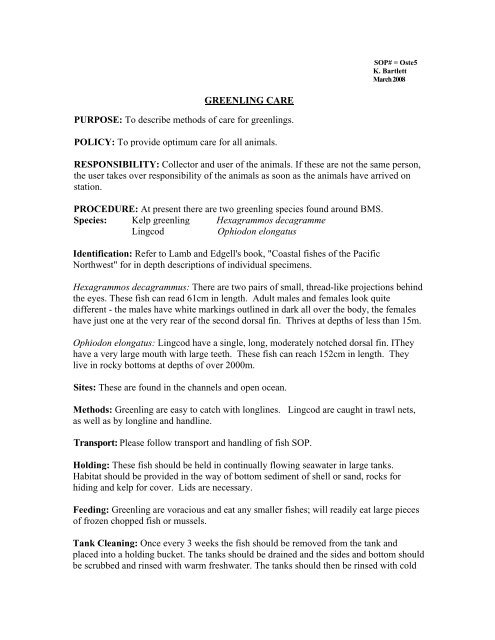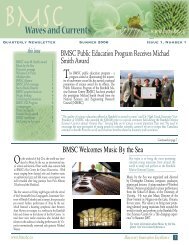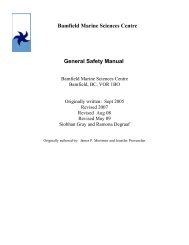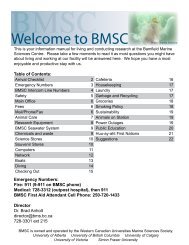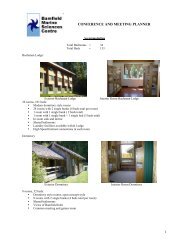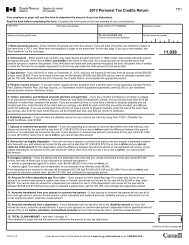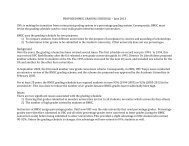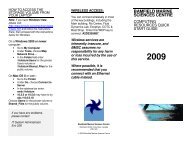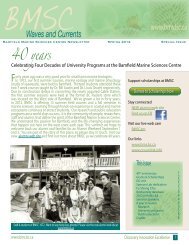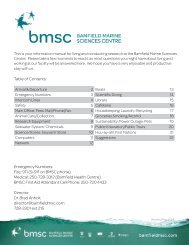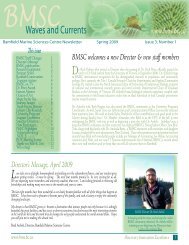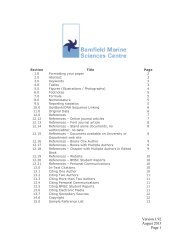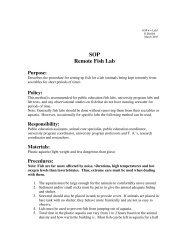GREENLING CARE PURPOSE: To describe methods of care for ...
GREENLING CARE PURPOSE: To describe methods of care for ...
GREENLING CARE PURPOSE: To describe methods of care for ...
Create successful ePaper yourself
Turn your PDF publications into a flip-book with our unique Google optimized e-Paper software.
SOP# = Oste5<br />
K. Bartlett<br />
March 2008<br />
<strong>GREENLING</strong> <strong>CARE</strong><br />
<strong>PURPOSE</strong>: <strong>To</strong> <strong>describe</strong> <strong>methods</strong> <strong>of</strong> <strong>care</strong> <strong>for</strong> greenlings.<br />
POLICY: <strong>To</strong> provide optimum <strong>care</strong> <strong>for</strong> all animals.<br />
RESPONSIBILITY: Collector and user <strong>of</strong> the animals. If these are not the same person,<br />
the user takes over responsibility <strong>of</strong> the animals as soon as the animals have arrived on<br />
station.<br />
PROCEDURE: At present there are two greenling species found around BMS.<br />
Species: Kelp greenling Hexagrammos decagramme<br />
Lingcod<br />
Ophiodon elongatus<br />
Identification: Refer to Lamb and Edgell's book, "Coastal fishes <strong>of</strong> the Pacific<br />
Northwest" <strong>for</strong> in depth descriptions <strong>of</strong> individual specimens.<br />
Hexagrammos decagrammus: There are two pairs <strong>of</strong> small, thread-like projections behind<br />
the eyes. These fish can read 61cm in length. Adult males and females look quite<br />
different - the males have white markings outlined in dark all over the body, the females<br />
have just one at the very rear <strong>of</strong> the second dorsal fin. Thrives at depths <strong>of</strong> less than 15m.<br />
Ophiodon elongatus: Lingcod have a single, long, moderately notched dorsal fin. IThey<br />
have a very large mouth with large teeth. These fish can reach 152cm in length. They<br />
live in rocky bottoms at depths <strong>of</strong> over 2000m.<br />
Sites: These are found in the channels and open ocean.<br />
Methods: Greenling are easy to catch with longlines. Lingcod are caught in trawl nets,<br />
as well as by longline and handline.<br />
Transport: Please follow transport and handling <strong>of</strong> fish SOP.<br />
Holding: These fish should be held in continually flowing seawater in large tanks.<br />
Habitat should be provided in the way <strong>of</strong> bottom sediment <strong>of</strong> shell or sand, rocks <strong>for</strong><br />
hiding and kelp <strong>for</strong> cover. Lids are necessary.<br />
Feeding: Greenling are voracious and eat any smaller fishes; will readily eat large pieces<br />
<strong>of</strong> frozen chopped fish or mussels.<br />
Tank Cleaning: Once every 3 weeks the fish should be removed from the tank and<br />
placed into a holding bucket. The tanks should be drained and the sides and bottom should<br />
be scrubbed and rinsed with warm freshwater. The tanks should then be rinsed with cold
seawater and allowed to refill, and the fish replaced<br />
Anesthetic: Anesthetizing these animals is size, species, and density dependent;<br />
approximately 0.2mg/L <strong>of</strong> MS-222. Always wear gloves when using MS-222.<br />
Clove oil is most effective as an anesthetic at concentrations <strong>of</strong> 40-60 mg/L, and should<br />
be dissolved in ethanol (e.g., 1:9) be<strong>for</strong>e mixing into the water. Clove oil has a slightly<br />
faster induction time and a longer recovery time than similar concentrations <strong>of</strong> MS-222.<br />
Clove oil has a wide margin <strong>of</strong> safety between effective and lethal doses, and fish do not<br />
show signs <strong>of</strong> distress when being anaesthetized.<br />
Euthanasia: Euthanasia is size, species, and density dependent; inhalant anesthetic overdose<br />
<strong>of</strong> 0.4 - 2.0 g/L <strong>of</strong> MS-222.<br />
Animal Return: Animals should be returned to the site <strong>of</strong> their collection. Be sure to<br />
have well oxygenated water in bucket that they are being returned in.<br />
If any anesthetic chemical has been used on the fish during it’s holding at BMSC, the<br />
animal must not be released be<strong>for</strong>e the drug withdrawal time. Withdrawal time should be<br />
on the label <strong>of</strong> an anesthetic in degree-days (degree-days are the accumulated thermal<br />
units <strong>for</strong> a given day. One day at 10C is 10 degree-days).<br />
Note: MS-222 has a 5 -day withdrawal time <strong>for</strong> salmon above 10C.<br />
DAILY ACTIVITIES:<br />
1. Ensure water is flowing into the tank at a reasonable rate.<br />
2. Ensure the standpipe is in place and not blocked.<br />
3. Check <strong>for</strong> and remove and dead animals.<br />
4. Check <strong>for</strong> and remove any uneaten prey organisms.<br />
5. Check <strong>for</strong> and remove and <strong>for</strong>eign organisms.


